 FERNANDO
DI LEO CRIME COLLECTION (1972-1976)
FERNANDO
DI LEO CRIME COLLECTION (1972-1976)Director: Fernando Di Leo
Raro Video/eOne
 FERNANDO
DI LEO CRIME COLLECTION (1972-1976)
FERNANDO
DI LEO CRIME COLLECTION (1972-1976)Raro Video/eOne follows up their debut release of Federico Fellini’s I CLOWNS (1970) with a well-priced boxed set four of Fernando Di Leo’s most entertaining Italian crime films. There’s shootouts, car chases, beating, stabbings, explosions (dig Henry Silva with that rocket launcher), naked women and plenty of gratuitous J&B product placement in THE FERNANDO DI LEO CRIME COLLECTION.
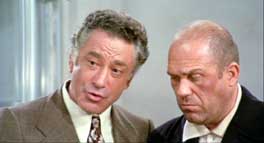
In CALIBER 9/MILANO CALIBRO 9 (1972), Ugo Piazza (Gastone Moschin, THE CONFORMIST) is released from prison after serving three years of a four year sentence for a botched bank robbery. As soon as he gets out, he is harassed by Rocco (Mario Adorf, WHAT HAVE THEY DONE TO OUR DAUGHTERS?) who works for The Americano (Lionel Stander, THE EROTICIST). They believe that Ugo made off with $300,000 in laundered money during an exchange and got himself purposefully arrested and imprisoned and The Americano wants to know where the money is. The police commissioner (Frank Wolff, THE LICKERISH QUARTET) offers to give Ugo the money in exchange for information on The Americano, but Ugo insists that he did not take the money. Even Ugo’s girlfriend Nelly (Barbara Bouchet, AMUCK!) does not believe that Ugo hasn’t stashed the money somewhere (despite him voicing his suspicions of Rocco or even The Americano himself). Ugo approaches hitman Chino (Philippe Leroy, MOTHER OF TEARS) – who cares for blind Don Vincenzo (Ivo Garrani, BLACK SUNDAY) – for help, but Chino does not want to get involved with The Americano. When Rocco bursts into the apartment and tries to intimidate Chino, Chino gives him what-for, which The Americano takes as an insult. The Americano takes Ugo back into the gang in hopes of tripping him up and revealing the location of the stolen loot. When another exchange results in more missing cash and a dead henchman, The Americano orders Ugo to assassinate the robber. When it turns out that the target is Chino, Ugo balks but Rocco gets off some shots and kills Don Vincenzo. Ugo is able to reason with The Americano and cast doubt on his suspicion of Chino, but now they have to worry about Chino’s revenge.
 CALIBER
9 was the first of Di Leo’s noir trilogy that also included THE ITALIAN
CONNECTION and THE BOSS, although he had previously adapted CALIBER 9 source
novel author Giorgio Scerbanenco’s I RAGAZZI DEL MASSACRO (known in the
U.S. as NAKED VIOLENCE). The near-wordless pre-credits sequence – to the
rhythms of Luis Bacalov’s main theme – traces the passing of a cache
of money across Milan into the hands of thugs Rocco and Pasquale, who discover
it to have been switched and take violent and explosive retribution, is a mini-masterpiece
in itself. Moschin is intense as the seemingly passive protagonist and Bouchet
is a perfect mix of love interest and possible femme fatale (despite a criminal
lack of screen time). Stander’s Americano is not a particularly impressive
character, but the villainous heavy lifting is handled admirably by Adorf as
the brutal and boastful Rocco (he is particularly intense during the violent
finale). Leroy is bad-ass as the cool hitman Chino. Luigi Pistilli (YOUR VICE
IS A LOCKED ROOM AND ONLY I HAVE THE KEY!) shows up for a handful of scenes
as the enlightened Deputy Commissioner Mercuri, who sees crime as an effect
of poverty and upper class corruption rather than a cause. His arguments with
Wolff’s police commissioner are well-played, but even Di Leo in the disc’s
featurette on the film thinks these scenes should have been cut (Wolff and Pistilli
never leave their office). Mario Novelli (SYNDICATE SADISTS) is memorable as
the twitchy thug Pasquale (he gets a great introductory shot shaking a pigeon
off his shoulder), as is Giuseppe Castellano (ISLAND OF THE FISHMEN), another
thug who intimidates the porter of Ugo’s fleabag motel while doing the
crossword puzzle. Salvatore Arico (one of Di Leo’s RAGAZZI DEL MASSACRO)
pops up with a little too much obvious emphasis.
CALIBER
9 was the first of Di Leo’s noir trilogy that also included THE ITALIAN
CONNECTION and THE BOSS, although he had previously adapted CALIBER 9 source
novel author Giorgio Scerbanenco’s I RAGAZZI DEL MASSACRO (known in the
U.S. as NAKED VIOLENCE). The near-wordless pre-credits sequence – to the
rhythms of Luis Bacalov’s main theme – traces the passing of a cache
of money across Milan into the hands of thugs Rocco and Pasquale, who discover
it to have been switched and take violent and explosive retribution, is a mini-masterpiece
in itself. Moschin is intense as the seemingly passive protagonist and Bouchet
is a perfect mix of love interest and possible femme fatale (despite a criminal
lack of screen time). Stander’s Americano is not a particularly impressive
character, but the villainous heavy lifting is handled admirably by Adorf as
the brutal and boastful Rocco (he is particularly intense during the violent
finale). Leroy is bad-ass as the cool hitman Chino. Luigi Pistilli (YOUR VICE
IS A LOCKED ROOM AND ONLY I HAVE THE KEY!) shows up for a handful of scenes
as the enlightened Deputy Commissioner Mercuri, who sees crime as an effect
of poverty and upper class corruption rather than a cause. His arguments with
Wolff’s police commissioner are well-played, but even Di Leo in the disc’s
featurette on the film thinks these scenes should have been cut (Wolff and Pistilli
never leave their office). Mario Novelli (SYNDICATE SADISTS) is memorable as
the twitchy thug Pasquale (he gets a great introductory shot shaking a pigeon
off his shoulder), as is Giuseppe Castellano (ISLAND OF THE FISHMEN), another
thug who intimidates the porter of Ugo’s fleabag motel while doing the
crossword puzzle. Salvatore Arico (one of Di Leo’s RAGAZZI DEL MASSACRO)
pops up with a little too much obvious emphasis.
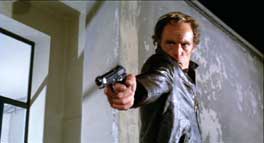
Bacalov’s score – in the first of his Di Leo collaborations – is partially derived from his recording sessions with the Italian progressive group “The New Trolls” for Maurizio Lucidi’s Venice-set STRANGERS ON A TRAIN-riff THE DESIGNATED VICTIM (1971) and performed by the progressive group Osanna. The main theme moves back and forth between solo piano, classical strings, and progressive rock with fuzz guitars and pan-pipes! Production designer Francesco Cuppini (THE FRIGHTENED WOMAN) – who designed the sets for all four films in the set– gets to show off some of his pop-art sensibilities in Barbara Bouchet’s apartment and the strip club where she performs. Franco Villa’s cinematography is attractive and largely unembellished, with the exception of the some tilting, sideways, and upside-down camera angles during Bouchet’s go-go dancing (Di Leo would later go crazy with these shots in SLAUGHTER HOTEL). Villa shot ten films for Di Leo and later gave much-needed polish to the Gabriele Cristiani productions GIALLA A VENEZIA, PATRICK LIVES AGAIN, MALABIMBA, and SATAN’S BABY DOLL.
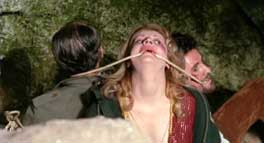 Raro/eOne’s
progressive 1.85:1 widescreen anamorphic transfer is attractive (and seemingly
free of edge enhancement). Both the Italian and English tracks are clean (the
English track is okay, but the voicing on the Italian track is superior –
especially in the case of Adorf’s character). Raro Italy split the film
and extras of MILANO CALIBRO 9 between two discs. Raro/eOne combines the feature
and the same extras (roughly 97 minutes of featurettes) onto one disc. While
the bitrate may possibly be lower (I have no idea if the feature disc on the
Italian set is single or dual-layer), the Raro Italy disc atypically lacked
English subtitles for the three documentaries and audio interview. “Calibro
9” (29:39) features input from director Fernando Di Leo, producer Armando
Novelli, editor Amedeo Giomini, actors Philippe Leroy and Barbara Bouchet, composer
Luis Enrique Bacalov, assistant director Franco Lo Cascio (who went on to direct
several adult features as Luca Damiano), writer Andrea G. Pinketts, and essayists
Maurizio Colombo and Luca Crovi. According to Bouchet, her dancing scene in
the beaded bikini was supposed to be on a closed set, yet a photo was leaked
to the newspapers (producer Novelli admits that he had a photographer sneak
a photo during the shooting). “Fernando Di Leo: the Genesis of the Genre”
(36:28) – which should have been translated as “moral of the genre”
– discusses Di Leo’s work in the western, noir and erotic genres
with input from Di Leo himself, actors Nino Castelnuovo, Gianni Garko, Pier
Paolo Capponi, Luc Merenda, Dagmar Lassander, Howard Ross, Jenny Tamburi, editor
Amedeo Giomini, cinematographer Franco Villa, and Nocturno producer Gianluca
Curti as well as clips from several of Di Leo’s films (hopefully we’ll
see some more of them from Raro/eOne). In “Scerbanenco Noir” (26:08),
Andrea G. Pinketts discusses the late author whose work was adapted by Di Leo
for NAKED VIOLENCE, CALIBER 9 (which Di Leo expanded by adding elements from
a couple other Scerbaneco stories), THE ITALIAN CONNECTION, the Di Leo-penned
YOUNG, VIOLENT, DANGEROUS, Lamberto Bava’s TV movie THE MAN WHO DIDN’T
WANT TO DIE, and Ducio Tessari’s DEATH OCCURRED LAST NIGHT. Gastone Moschin
is heard in a phone interview over a stills gallery (3:26) with English subtitles.
The standard director's biography and filmography round out the extras.
Raro/eOne’s
progressive 1.85:1 widescreen anamorphic transfer is attractive (and seemingly
free of edge enhancement). Both the Italian and English tracks are clean (the
English track is okay, but the voicing on the Italian track is superior –
especially in the case of Adorf’s character). Raro Italy split the film
and extras of MILANO CALIBRO 9 between two discs. Raro/eOne combines the feature
and the same extras (roughly 97 minutes of featurettes) onto one disc. While
the bitrate may possibly be lower (I have no idea if the feature disc on the
Italian set is single or dual-layer), the Raro Italy disc atypically lacked
English subtitles for the three documentaries and audio interview. “Calibro
9” (29:39) features input from director Fernando Di Leo, producer Armando
Novelli, editor Amedeo Giomini, actors Philippe Leroy and Barbara Bouchet, composer
Luis Enrique Bacalov, assistant director Franco Lo Cascio (who went on to direct
several adult features as Luca Damiano), writer Andrea G. Pinketts, and essayists
Maurizio Colombo and Luca Crovi. According to Bouchet, her dancing scene in
the beaded bikini was supposed to be on a closed set, yet a photo was leaked
to the newspapers (producer Novelli admits that he had a photographer sneak
a photo during the shooting). “Fernando Di Leo: the Genesis of the Genre”
(36:28) – which should have been translated as “moral of the genre”
– discusses Di Leo’s work in the western, noir and erotic genres
with input from Di Leo himself, actors Nino Castelnuovo, Gianni Garko, Pier
Paolo Capponi, Luc Merenda, Dagmar Lassander, Howard Ross, Jenny Tamburi, editor
Amedeo Giomini, cinematographer Franco Villa, and Nocturno producer Gianluca
Curti as well as clips from several of Di Leo’s films (hopefully we’ll
see some more of them from Raro/eOne). In “Scerbanenco Noir” (26:08),
Andrea G. Pinketts discusses the late author whose work was adapted by Di Leo
for NAKED VIOLENCE, CALIBER 9 (which Di Leo expanded by adding elements from
a couple other Scerbaneco stories), THE ITALIAN CONNECTION, the Di Leo-penned
YOUNG, VIOLENT, DANGEROUS, Lamberto Bava’s TV movie THE MAN WHO DIDN’T
WANT TO DIE, and Ducio Tessari’s DEATH OCCURRED LAST NIGHT. Gastone Moschin
is heard in a phone interview over a stills gallery (3:26) with English subtitles.
The standard director's biography and filmography round out the extras.

In THE ITALIAN CONNECTION/LA MALA ORDINA (1972) – also known as BLACK KINGPIN, HIRED TO KILL, or MANHUNT – unlikely mob boss Corso (Cyril Cusack, THE DEVIL'S WIDOW) sends Dave Catania (Henry Silva, CRY OF A PROSTITUTE) and Frank Webster (Woody Strode, BOOT HILL) to Italy to assassinate pimp Luca Canali (Adorf again) in a most public and gruesome manner to send a message to the Italian mafia as to how New York deals with troublemakers. They are instructed to not be conspicuous in their behavior as New York gangsters. Their lovely guide Eva (Luciana Paluzzi, TRAGIC CEREMONY AT VILLA ALEXANDER) not so willingly takes them through the fleshpots of the city in search of Canali. Before they can make a move on Canali, they must get the consent of Don Vito Tressoldi (Adolfo Celi, LIVE LIKE A COP, DIE LIKE A MAN). He sends his men to collect Canali, but Canali doesn’t take kindly to being roughed up and escape (after administering a beating to his captors). Canali, still unaware of why he is being targeted, dodges Tressoldi’s men as well as Catania and Webster. When Don Vito targets his ex Lucia (Sylvia Koscina, LISA AND THE DEVIL) and his daughter Rita (Lara Wendel, TENEBRE), Canali stops running and takes up the guns and blunt instruments.
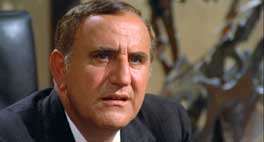 If
you liked CALIBER 9, you’re in for a surprise. Di Leo has upped the violence
considerably in THE ITALIAN CONNECTION. The gangsters here don’t mess
around. Canali’s mistress gets roughed up in a particularly disturbing
scene, but that’s only a teaser for a particularly abrupt and shocking
hit-and-run (which precedes an exciting set-piece of a car chase/foot chase).
Adorf as Luca Canali is brutal-yet-charismatic and you’ll find yourself
rooting for him (even though he’s a pimp and no more gentle than Catania,
Webster, or Don Vito’s men). Smirking Silva and stoic Strode don’t
hold back any punches (or gouges), but both disappear from the middle of the
film when Adorf takes center-stage. Paluzzi as Eva withstands Catania’s
flirtations (and the underlying threat of violence), but has little else to
do until the finale. Celi is his usual smiling, menacing self (Celi, of course,
had previously shared the screen with Paluzzi in THUNDERBALL). Femi Benussi
(THE KILLER MUST KILL AGAIN) gets a bit more dialogue than usual as Canali’s
mistress, before she’s stripped and roughed up. Jessica Dublin (ISLAND
OF DEATH) plays a lovable drunk hotel guest who thinks she’s in Sweden.
Polish actor Peter Berling (who went on to co-script Di Leo’s RULERS OF
THE CITY) plays one of Don Vito’s advisors and Gianni Macchia (who also
starred in Di Leo’s MADNESS with Joe D’Allessandro) plays one of
Canali’s allies. Luis Bacalov sits this Di Leo effort out and the less
adventurous but nicely loungey score here (along with some very 1960s cheesy
vocals) is provided by Armando Travajoli (BLAZING MAGNUMS).
If
you liked CALIBER 9, you’re in for a surprise. Di Leo has upped the violence
considerably in THE ITALIAN CONNECTION. The gangsters here don’t mess
around. Canali’s mistress gets roughed up in a particularly disturbing
scene, but that’s only a teaser for a particularly abrupt and shocking
hit-and-run (which precedes an exciting set-piece of a car chase/foot chase).
Adorf as Luca Canali is brutal-yet-charismatic and you’ll find yourself
rooting for him (even though he’s a pimp and no more gentle than Catania,
Webster, or Don Vito’s men). Smirking Silva and stoic Strode don’t
hold back any punches (or gouges), but both disappear from the middle of the
film when Adorf takes center-stage. Paluzzi as Eva withstands Catania’s
flirtations (and the underlying threat of violence), but has little else to
do until the finale. Celi is his usual smiling, menacing self (Celi, of course,
had previously shared the screen with Paluzzi in THUNDERBALL). Femi Benussi
(THE KILLER MUST KILL AGAIN) gets a bit more dialogue than usual as Canali’s
mistress, before she’s stripped and roughed up. Jessica Dublin (ISLAND
OF DEATH) plays a lovable drunk hotel guest who thinks she’s in Sweden.
Polish actor Peter Berling (who went on to co-script Di Leo’s RULERS OF
THE CITY) plays one of Don Vito’s advisors and Gianni Macchia (who also
starred in Di Leo’s MADNESS with Joe D’Allessandro) plays one of
Canali’s allies. Luis Bacalov sits this Di Leo effort out and the less
adventurous but nicely loungey score here (along with some very 1960s cheesy
vocals) is provided by Armando Travajoli (BLAZING MAGNUMS).
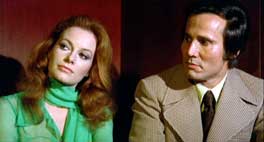
Raro/eOne’s progressive 1.85:1 widescreen anamorphic transfer of THE ITALIAN CONNECTION features good condition Italian and English mono audio tracks and optional English subtitles (the English track is somewhat louder and more effective). Besides the usual text director biography/filmography and a photo gallery, the only extra on the disc is “Roots of the Mafia” (20:35) features Di Leo, writer Maurizio Colombo, editor Amedeo Giomini, cinematographer Franco Villa, assistant director Franco Lo Cascio, essayist Luca Crovi, producer Armando Novelli, actress Francesca Romana Coluzzi (who plays a blue-haired prostitute in the film). Di Leo’s comments will ease the minds of some viewers regarding the use of a kitten in the junkyard scene.
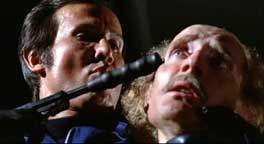 Henry
Silva’s back again in THE BOSS/IL BOSS (1973) as hitman Lanzetta, who
uses a grenade-launcher to take out Don Attardi (Andrea Aureli, LADY FRANKENSTEIN)
and several of his men while at a private porno screening. Cocchi (Pier Paolo
Capponi, FORBIDDEN PHOTOS OF A LADY ABOVE SUSPICION) rightly suspects Don Daniello
(Claudio Nicastro, HOW TO KILL A JUDGE) behind the hit and vows revenge. Not
wanting a mafia war in his district, Commissioner Torri (Gianni Garko, COLD
EYES OF FEAR) warns Don Carrasco (Richard Conte, CRIES AND WHISPERS) of Cocchi’s
plans. Torri suggests to his superior (Vittorio Caprioli, RULERS OF THE CITY)
that his policy of exiling the old Dons has caused their remaining families
to scramble for territory, but he is aware that Torri is corrupt. Carasco wants
to get rid of Cocchi before he can grab Attardi’s empire. Don Daniello
(Claudio Nicastro, HOW TO KILL A JUDGE) – advised by lawyer Rizzo (Corrado
Gaipa, MY DEAR KILLER) – suggests that things can be smoothed over by
bringing Cocchi into the family. Carasco balks at this because Cocchi is Calabrian
rather than Sicilian. Cocchi’s men kidnap Don Daniello’s teenage
daughter Rina (Antonia Santilli, DECAMEROTICUS) and demand the Don’s life
in exchange for his daughter’s. Daniello is willing to sacrifice himself
but Carrasco knows that Cocchi’s men would torture him for his mafia contacts
before killing him. Meanwhile, Cocchi’s men have some fun with Rina (lead,
of course, by NEW YORK RIPPER’s Howard Ross), who turns out to be not
so innocent. Carrasco has Lanzetta kill Daniello when he tries to rescue his
daughter and sends Lanzetta to do away with the rest of Cocchi’s men.
When Cocchi prevents Don Attardi’s grief-stricken brother Carlo (Gianni
Mussy, THE STATUE) from killing Rina, he betrays their whereabouts to Lanzetta.
Lanzetta rescues her, screws her, and smacks her around (turns out she doesn’t
mind). Rizzo informs Carrasco that Rome and Palermo insist that he make either
make peace with Cocchi or get rid of him quickly. Cocchi orders Lanzetta to
use all the men he wants to decimate Cocchi’s gang, but Cocchi survives.
Rizzo tells Carrasco that Cocchi believes Lanzetta to be solely responsible
and is willing to make peace with him. To please the corrupt law enforcement
(and the clergy!), however, Rizzo tells Carrasco they need to make Lanzetta
a scapegoat for the massacre. Carrasco provides Torri with the means to arrest
Lanzetta, but Lanzetta isn’t going out without a lot of casualties.
Henry
Silva’s back again in THE BOSS/IL BOSS (1973) as hitman Lanzetta, who
uses a grenade-launcher to take out Don Attardi (Andrea Aureli, LADY FRANKENSTEIN)
and several of his men while at a private porno screening. Cocchi (Pier Paolo
Capponi, FORBIDDEN PHOTOS OF A LADY ABOVE SUSPICION) rightly suspects Don Daniello
(Claudio Nicastro, HOW TO KILL A JUDGE) behind the hit and vows revenge. Not
wanting a mafia war in his district, Commissioner Torri (Gianni Garko, COLD
EYES OF FEAR) warns Don Carrasco (Richard Conte, CRIES AND WHISPERS) of Cocchi’s
plans. Torri suggests to his superior (Vittorio Caprioli, RULERS OF THE CITY)
that his policy of exiling the old Dons has caused their remaining families
to scramble for territory, but he is aware that Torri is corrupt. Carasco wants
to get rid of Cocchi before he can grab Attardi’s empire. Don Daniello
(Claudio Nicastro, HOW TO KILL A JUDGE) – advised by lawyer Rizzo (Corrado
Gaipa, MY DEAR KILLER) – suggests that things can be smoothed over by
bringing Cocchi into the family. Carasco balks at this because Cocchi is Calabrian
rather than Sicilian. Cocchi’s men kidnap Don Daniello’s teenage
daughter Rina (Antonia Santilli, DECAMEROTICUS) and demand the Don’s life
in exchange for his daughter’s. Daniello is willing to sacrifice himself
but Carrasco knows that Cocchi’s men would torture him for his mafia contacts
before killing him. Meanwhile, Cocchi’s men have some fun with Rina (lead,
of course, by NEW YORK RIPPER’s Howard Ross), who turns out to be not
so innocent. Carrasco has Lanzetta kill Daniello when he tries to rescue his
daughter and sends Lanzetta to do away with the rest of Cocchi’s men.
When Cocchi prevents Don Attardi’s grief-stricken brother Carlo (Gianni
Mussy, THE STATUE) from killing Rina, he betrays their whereabouts to Lanzetta.
Lanzetta rescues her, screws her, and smacks her around (turns out she doesn’t
mind). Rizzo informs Carrasco that Rome and Palermo insist that he make either
make peace with Cocchi or get rid of him quickly. Cocchi orders Lanzetta to
use all the men he wants to decimate Cocchi’s gang, but Cocchi survives.
Rizzo tells Carrasco that Cocchi believes Lanzetta to be solely responsible
and is willing to make peace with him. To please the corrupt law enforcement
(and the clergy!), however, Rizzo tells Carrasco they need to make Lanzetta
a scapegoat for the massacre. Carrasco provides Torri with the means to arrest
Lanzetta, but Lanzetta isn’t going out without a lot of casualties.

Whereas CALIBER 9 and THE ITALIAN CONNECTION were based on novels by Milanese author Giorgio Scerbanenco, THE BOSS was based on the novel “Mafioso” by Irish-born American pulp writer Peter McCurtin. The plot is more labyrinthine than the prior two films; appropriate for a novel about a power grab, but a little taxing on the film viewer (the 112 minute running time is bloated by three static expository dialogue scenes with Caprioli and Mario Pisu (JULIET OF THE SPIRITS) to little effect, and they are not as intensely played as the Wolff/Pistilli scenes in CALIBER 9). The abduction of Rina affords the film a healthy helping of sleaze (in case you felt cheated by not getting to see any of the Scandanavian porno film from the pre-credits sequence). The montage of Lanzetta and Carrasco’s men taking out Cocchi’s group packs a lot of killing into a couple minutes (all to the tune of Bacalov’s theme) and Di Leo keeps the carnage varied for the viewer’s entertainment.
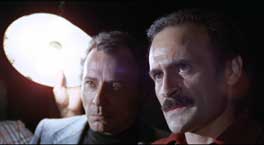 If
viewers were a little disappointed by the side-lining of Silva for most of THE
ITALIAN CONNECTION, they’ll be more satisfied to see him taking center
stage here. Lanzetta is a more complex character: an orphan raised by Daniello,
who then kills the older man under orders from Carrasco, yet still takes the
time out of going after Cocchi’s men to rescue Daniello’s not-too-appreciative
daughter. Fresh off his previous mafia don role in THE GODFATHER (1972), Conte
is more lively here than in some of his other Italian productions (DIARY OF
AN EROTIC MURDERESS, the late and not-so-great “Exorcist” clone
CRIES AND WHISPERS/THE POSSESSOR) before his death, but it is Gaipa’s
“avvocato” – with orders from higher up – who drives
the plot. Capponi may be more familiar as somewhat of a background fixture in
better known films such as Dario Argento’s CAT O’NINE TAILS (1971)
and Umberto Lenzi’s SEVEN BLOOD-STAINED ORCHID (1972) in which he played
police detectives. He revels in the showier role of Cocchi (check out the switchblade
scene). Capponi also starred alongside his FORBIDDEN PHOTOS OF A LADY ABOVE
SUSPICION co-star Susan Scott as the leads in Di Leo’s NAKED VIOLENCE.
Garko drifts in and out of the picture as compromised commissioner who seems
to go from coolly corrupt to delusional in his beliefs about the nature of the
exiled don's collaboration with law enforcement (it is great to see him squirm
at gunpoint late in the film). Santilli is a standout as Daniello’s ballsy,
drug-addicted, nymphomaniacal, student protestor daughter who enjoys needling
Lanzetta despite the palpable threat of physical violence. Marino Mase (THE
RED QUEEN KILLS SEVEN TIMES) plays Carrasco’s godson, who becomes more
prominent in the film’s final third. Bacalov returned after sitting it
out for THE ITALIAN CONNECTION (actually, he was quite busy during this period,
and is still quite active in film scoring) and his fuzz guitars further energize
Di Leo’s direction and Amedeo Giomini’s editing. Franco Villa is
on hand again as cinematographer. Carrasco’s villa exterior and interior
will be familiar to Eurocult viewers from Sergio Martino’s TORSO (1973).
If
viewers were a little disappointed by the side-lining of Silva for most of THE
ITALIAN CONNECTION, they’ll be more satisfied to see him taking center
stage here. Lanzetta is a more complex character: an orphan raised by Daniello,
who then kills the older man under orders from Carrasco, yet still takes the
time out of going after Cocchi’s men to rescue Daniello’s not-too-appreciative
daughter. Fresh off his previous mafia don role in THE GODFATHER (1972), Conte
is more lively here than in some of his other Italian productions (DIARY OF
AN EROTIC MURDERESS, the late and not-so-great “Exorcist” clone
CRIES AND WHISPERS/THE POSSESSOR) before his death, but it is Gaipa’s
“avvocato” – with orders from higher up – who drives
the plot. Capponi may be more familiar as somewhat of a background fixture in
better known films such as Dario Argento’s CAT O’NINE TAILS (1971)
and Umberto Lenzi’s SEVEN BLOOD-STAINED ORCHID (1972) in which he played
police detectives. He revels in the showier role of Cocchi (check out the switchblade
scene). Capponi also starred alongside his FORBIDDEN PHOTOS OF A LADY ABOVE
SUSPICION co-star Susan Scott as the leads in Di Leo’s NAKED VIOLENCE.
Garko drifts in and out of the picture as compromised commissioner who seems
to go from coolly corrupt to delusional in his beliefs about the nature of the
exiled don's collaboration with law enforcement (it is great to see him squirm
at gunpoint late in the film). Santilli is a standout as Daniello’s ballsy,
drug-addicted, nymphomaniacal, student protestor daughter who enjoys needling
Lanzetta despite the palpable threat of physical violence. Marino Mase (THE
RED QUEEN KILLS SEVEN TIMES) plays Carrasco’s godson, who becomes more
prominent in the film’s final third. Bacalov returned after sitting it
out for THE ITALIAN CONNECTION (actually, he was quite busy during this period,
and is still quite active in film scoring) and his fuzz guitars further energize
Di Leo’s direction and Amedeo Giomini’s editing. Franco Villa is
on hand again as cinematographer. Carrasco’s villa exterior and interior
will be familiar to Eurocult viewers from Sergio Martino’s TORSO (1973).
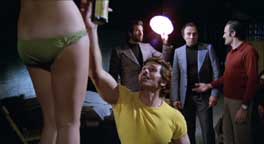
Raro/eOne’s 1.85:1 widescreen anamorphic, dual-layer, progressive transfer is once again quite satisfying, and the English and Italian mono tracks are in good condition (although there are signs that they have been digitally cleaned up). The English track is a bit punchier than the Italian. The English track reverts to Italian for about fifty seconds during the morgue scene, so you’ll have to turn on the subs. Watching the film in English with subs is just as interesting and experience with this film as with the others, considering how much the English and Italian tracks differ from one another (“I’m going to bang you now,” in Italian, becomes “Now, let’s have some fun,” in English). “Stories About the Mafia” features input from actors Gianni Garko, Pier Paolo Capponi, Gianni Mussy, and Howard Ross along with director Fernando Di Leo, producer Armando Novelli, and editor Amedeo Giomini. In the set’s only big authoring error, Raro/eOne trimmed out the Nocturno Horror Club logo but forgot to remove the corresponding audio segment (that ear-splitting logo music) so the entire featurette is out of sync (NOTE: The sync issues on the THE BOSS' documentary featurette have been repaired on the DLT tapes for future pressings). The subtitles are in sync with the mouth movements, but all of the Italian audio lags way behind the speakers. If you just read the subs, the documentary is as informative about the film as the docs on the other disc, but it can be distracting. A photo gallery and director’s filmography and biography round out the package.
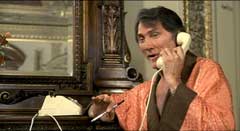 RULERS
OF THE CITY/I PADRONI DELLA CITTÀ (1976) – which American viewers
may have seen as MISTER SCARFACE (courtesy of PRO International Pictures) –
is an atypical Di Leo crime film. Sure there’s lots of fights, shootouts,
and stuntwork (along with a dollop of nudity), but it is also more light-hearted
and quite funny throughout. Tony (Harry Baer, BERLIN ALEXANDERPLATZ) is a low-rung
protection money collector for Luigi Chercio (Edmund Purdom, THE FIFTH CORD).
He gets all of the smaller collections – and the resulting lower commissions
– for a lot of work (including some weekly fisticuffs with one resistant
client). He is the butt of jokes about his manliness because he is the only
one of the gang who has not slept with Clara (Gisela Hahn, CONTAMINATION), although
she’s eager to try him out. When Manzari (Jack Palance, JUSTINE) –
aka Scarface – deliberately passes a bad check for three million lire
in Luigi’s gambling hall, Tony begs Luigi to let him get the money back
from Manzari. The rest of Luigi’s men are content to let him get himself
killed in the effort. Fortunately, Tony has made the acquaintance of Ric (Al
Cliver, ZOMBI 2) – freshly ousted from Manzari’s gang – who
comes up with a con to recover the money. Tony and an actor pose as tax inspectors
and barge into Manzari’s office while he is at home. Eager to prevent
the discovery of the contents of a folder on his desk, Manzari tells his second-in-command
Luca (Roberto Reale, TO BE TWENTY) to pass them a ten million lire bribe. Tony
is brash enough to leave Manzari the bad check, which sends Luigi into a panic.
He skips town and leaves Beppe (Enzo Pulcrano, THE KIDNAP SYNDICATE) in charge.
Beppe quickly spills the beans about Tony to Manzari. Beppe kills Luigi and
is promised a top position by Manzari in exchange for Tony. Beppe sets Luigi’s
band of protection collectors, purse snatchers, and burglars after Tony, with
the help of Manzari’s gunmen, but veteran hood Napoli (Vittorio Caprioli,
TOUT VA BIEN) helps Tony and Ric stay one step ahead of them (Manzari and co.
are unaware that Ric is helping Tony). Ric sets up a dope deal between Manzari
and non-existent South Americans for a final confrontation at an old slaughterhouse
that figures into Scarface’s past.
RULERS
OF THE CITY/I PADRONI DELLA CITTÀ (1976) – which American viewers
may have seen as MISTER SCARFACE (courtesy of PRO International Pictures) –
is an atypical Di Leo crime film. Sure there’s lots of fights, shootouts,
and stuntwork (along with a dollop of nudity), but it is also more light-hearted
and quite funny throughout. Tony (Harry Baer, BERLIN ALEXANDERPLATZ) is a low-rung
protection money collector for Luigi Chercio (Edmund Purdom, THE FIFTH CORD).
He gets all of the smaller collections – and the resulting lower commissions
– for a lot of work (including some weekly fisticuffs with one resistant
client). He is the butt of jokes about his manliness because he is the only
one of the gang who has not slept with Clara (Gisela Hahn, CONTAMINATION), although
she’s eager to try him out. When Manzari (Jack Palance, JUSTINE) –
aka Scarface – deliberately passes a bad check for three million lire
in Luigi’s gambling hall, Tony begs Luigi to let him get the money back
from Manzari. The rest of Luigi’s men are content to let him get himself
killed in the effort. Fortunately, Tony has made the acquaintance of Ric (Al
Cliver, ZOMBI 2) – freshly ousted from Manzari’s gang – who
comes up with a con to recover the money. Tony and an actor pose as tax inspectors
and barge into Manzari’s office while he is at home. Eager to prevent
the discovery of the contents of a folder on his desk, Manzari tells his second-in-command
Luca (Roberto Reale, TO BE TWENTY) to pass them a ten million lire bribe. Tony
is brash enough to leave Manzari the bad check, which sends Luigi into a panic.
He skips town and leaves Beppe (Enzo Pulcrano, THE KIDNAP SYNDICATE) in charge.
Beppe quickly spills the beans about Tony to Manzari. Beppe kills Luigi and
is promised a top position by Manzari in exchange for Tony. Beppe sets Luigi’s
band of protection collectors, purse snatchers, and burglars after Tony, with
the help of Manzari’s gunmen, but veteran hood Napoli (Vittorio Caprioli,
TOUT VA BIEN) helps Tony and Ric stay one step ahead of them (Manzari and co.
are unaware that Ric is helping Tony). Ric sets up a dope deal between Manzari
and non-existent South Americans for a final confrontation at an old slaughterhouse
that figures into Scarface’s past.
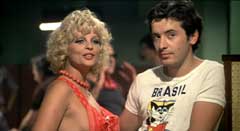
Baer and Cliver are likable leads and their characters are contrasted in terms of their fighting skills. Cool Ric is an expert shot, while jocular Tony is good with his fists (and feet). Purdom and Palance are not particularly formidable mobsters. Luigi constantly defers to Napoli’s advice in front of his men while Manzari is easily flustered, both are manipulated by underlings. Hahn sings two songs – undubbed – during the strip club scenes, but is largely window-dressing (Hahn and Cliver would team up once more in the far lesser Jess Franco cannibal pic DEVIL HUNTER). Nello Pazzafini (A LONG RIDE FROM HELL) also has a small supporting role. Weapons consultant Gilberto Galimberti doubles as one of Manzari’s thugs. Luis Bacalov’s (DJANGO) score for this crime thriller is just as idiosyncratic as his spaghetti western works. Erico Menczer’s (Argento’s CAT O’NINE TAILS) cinematography is not particularly showy (other than the strip club scene) but always attractive. Di Leo’s credited co-writer was Polish actor Peter Berling (AGUIRRE, WRATH OF GOD), although it is difficult to discern whether he contributed or was credited for co-production purposes (like RULERS OF THE CITY, his other writing credits such as RED RINGS OF FEAR and MALADOLESCENZA were co-produced with West Germany). Berling appears briefly onscreen (he also co-starred in THE ITALIAN CONNECTION). The opening childhood trauma flashback is a bit FOR A FEW DOLLARS MORE, but its resurgence in the story proper is a touch giallo-esque.
 As
with the Italian Raro individual and Di Leo set release, Raro/eOne’s transfer
of RULERS OF THE CITY is the only non-anamorphic widescreen (1.85:1) transfer
in the set, but just about anything is an improvement over the many VHS-sourced
budget bin MISTER SCARFACE DVDs (one of which has “video calibration”
popping up onscreen throughout, and another completely black for the final fifteen
minutes). The English audio has a couple loud clicks over Edmund Purdom’s
first shot (the Italian track one more muffled click on this spot). Both tracks
are worth a listen, as the translations have some interesting variations in
dialogue. For the most part, the English track has more character (Napoli calls
Manzari’s man Luca a “champion sprinter” on the Italian track,
and “rocket ass” on the English one). The documentary “Città
Violenta” (15:31) – which has nothing to do with the Charles Bronson/Sergio
Solimma film – features interviews with actor Al Cliver, director Fernando
Di Leo, editor Amedeo Giomini, and weapons master Gilberto Galimberti. The featurette
is well-edited, dovetailing between the comments of the participants without
seeming contrived. Giomini accurately describes the film as unpretentious and
entertaining. A text biography/filmography for Di Leo rounds out the extras
on the disc.
As
with the Italian Raro individual and Di Leo set release, Raro/eOne’s transfer
of RULERS OF THE CITY is the only non-anamorphic widescreen (1.85:1) transfer
in the set, but just about anything is an improvement over the many VHS-sourced
budget bin MISTER SCARFACE DVDs (one of which has “video calibration”
popping up onscreen throughout, and another completely black for the final fifteen
minutes). The English audio has a couple loud clicks over Edmund Purdom’s
first shot (the Italian track one more muffled click on this spot). Both tracks
are worth a listen, as the translations have some interesting variations in
dialogue. For the most part, the English track has more character (Napoli calls
Manzari’s man Luca a “champion sprinter” on the Italian track,
and “rocket ass” on the English one). The documentary “Città
Violenta” (15:31) – which has nothing to do with the Charles Bronson/Sergio
Solimma film – features interviews with actor Al Cliver, director Fernando
Di Leo, editor Amedeo Giomini, and weapons master Gilberto Galimberti. The featurette
is well-edited, dovetailing between the comments of the participants without
seeming contrived. Giomini accurately describes the film as unpretentious and
entertaining. A text biography/filmography for Di Leo rounds out the extras
on the disc.
While Raro Video/eOne housed their disc of Fellini’s I CLOWNS in a digipack beside a booklet in a thin cardboard sleave, they have put their four Di Leo discs in slimline cases alongside a booklet in a sturdier cardboard case. Retailing for $39.99, Raro Video/eOne’s FERNANDO DI LEO CRIME COLLECTION can be found at most online retailers for ten dollars cheaper. While owners of the Raro Italy set (or the individual titles) may not have much cause to upgrade (since RULERS OF THE CITY is not in 16:9), fans who do not own that set may want to go for this version since it is a good deal (and cheaper to import anyway) with the same extras and likely comparable picture quality. (Eric Cotenas)